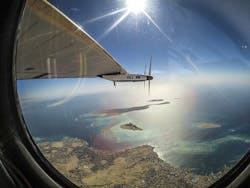Solar Impulse 2 powered by Kokam NMC batteries in historic first flight around the world by zero-fuel solar airplane
SEOUL, South Korea, 23 Aug. 2016. Batteries based on advanced ultra-high-energy lithium nickel manganese cobalt (NMC) oxide, or ultra-high-energy NMC, battery technology from battery manufacturer Kokam Co. Ltd. in Seoul, South Korea, powered the Solar Impulse 2 zero-fuel solar airplane’s record-breaking flight around the world, reveals a Kokam representative.
On 26 July 2016, the Solar Impulse completed the final leg of its historic trip, taking off from Cairo, Egypt, and landing 48 hours later in Abu Dhabi, United Arab Emirates.
The Solar Impulse uses four 38.5-kilowatt hour (kWh) Kokam Ultra High Energy NMC battery packs with 150 Ah cells, totaling 154 kWh of energy storage. Over the course of 17 flights totaling 26,744 miles (43,041 kilometers), the Solar Impulse 2’s 17,248 solar cells produced 11,000 kWh of electricity, much of which was stored in its Kokam Ultra High Energy NMC batteries and then discharged to power the plane at night.
Kokam’s Ultra High Energy NMC batteries feature an energy density of approximately 260 watt hours per kilogram (Wh/kg), enabling the Solar Impulse 2 to store more energy without increasing the plane’s weight or size. In addition, Kokam’s Ultra High Energy NMC batteries boast 96 percent efficiency, so less energy is wasted when the batteries charge or discharge.
Kokam’s NMC battery technology’s high energy density and efficiency, along with its ability to operate over a wide range of temperature, humidity, and pressure conditions, led the Solar Impulse team to select Kokam’s NMC battery technology for both the first prototype, the Solar Impulse 1, which was the first zero-fuel solar airplane to fly between continents and across the continental United States, and the current and second prototype, the Solar Impulse 2, which is the first zero-fuel solar airplane to circumnavigate the globe, officials say.
“We had to find and use the most advanced solar, material and battery technologies available on the market at the time of the design to build a plane capable of flying around the world using only the power of the sun,” recalls André Borschberg, co-founder, CEO, and pilot of Solar Impulse. “What was critical was to get the lightest and most energy-efficient solution, and we consequently selected Kokam’s Ultra High Energy NMC batteries, which has been our battery solution since the first flight of Solar Impulse 1 in December 2009 until the final leg landing of Solar Impulse 2 in Abu Dhabi in July 2016.”
“The Solar Impulse team and Kokam share a common vision – to create a world powered by non-polluting renewable energy,” describes Ike Hong, vice president of Kokam’s Power Solutions Division. “By choosing to use our advanced Ultra High Energy NMC battery technology, the Solar Impulse validates Kokam’s belief that, by continually working to develop more powerful, efficient and cost-effective battery technologies, Kokam can play an important role in accelerating the transition to a clean, electrified global economy.”
In April, Kokam introduced a variety of new high-energy battery solutions based on its advanced Ultra High Energy NMC battery technology for unmanned aerial vehicles (UAVs), also called unmanned aircraft systems (UAS) or drones, and other unmanned systems. In addition, dozens of customers around the world currently use Kokam’s advanced battery solutions for UAV, electric plane, and other aviation applications, including industry leaders Airbus, Trimble, ECA Group, and FT Sistemas, officials explain.
During the most challenging leg of the Solar Impulse 2’s flight around the world – the five-day and -night record-breaking flight from Nagoya, Japan, to Hawaii – the Solar Impulse 2’s battery temperature increased due to a different flight profile than the one planned and the over-insulation of the gondolas (engine housings) in relation to the outside temperature. As a result, the Solar Impulse 2’s Ultra High Energy NMC batteries were heated to a temperature close to 50 degrees Celsius for an extended period of time – a temperature higher than the design specifications.
It was impossible to rule out capacity loss or other damage to the batteries with the facilities available in Hawaii; for safety reasons, the Solar Impulse team decided to replace the batteries with new ones. Later, post flight tests of the original batteries at a facility in Germany determined that the batteries were undamaged, with only a small decrease in the capacity of the batteries compared to their original capacity in November 2013. Given the use of the batteries for two years, this level of capacity loss is normal.
To avoid potential overheating of its batteries in the future, the Solar Impulse team installed a new cooling system designed to prevent any temperature-related problems if the flight mission profile changes. In addition, in case the cooling system breaks down, a new backup system allows the pilot to manually open the container’s vent, allowing him to use outside air to cool the batteries without letting them get too cold and freeze. Futher, a few adjustments have been made to the engine housing (or gondola), which shelters both the battery and engine: an air vent was added to let air flow into the battery’s cooling system. The Solar Impulse team also ensured that future flight plans provided the batteries with sufficient time to cool between flights, and adjusted its flight planning to avoid overheating batteries in tropical climates.
“When you are designing an experimental aircraft every additional system is a potential source of failure, and that is why we had not initially integrated a cooling system. As we had the time in Hawaii to replace the batteries, we decided to integrate the cooling system to give the airplane more flexibility, especially in very high temperature environments,” Borschberg adds. “The overheating problem was in no way related to any issue with Kokam’s batteries, which have delivered excellent performance for Solar Impulse 1 and on every leg of the flight with Solar Impulse 2, supporting our record-breaking circumnavigation of the globe.”
With a proprietary manufacturing technology, Kokam Co. Ltd. has provided a wide range of lithium ion/polymer battery solutions to customers in over 50 countries and many different industries, including the military, aerospace, marine, electric vehicle (EV), energy storage system (ESS), and industrial markets.
Search the Aerospace & Defense Buyer's Guide
You might also like:
Subscribe today to receive all the latest aerospace technology and engineering news, delivered directly to your e-mail inbox twice a week (Tuesdays and Thursdays). Sign upfor your free subscription to the Intelligent Inbox e-newsletter at http://www.intelligent-aerospace.com/subscribe.html.
Connect with Intelligent Aerospace on social media: Twitter (@IntelligentAero), LinkedIn,Google+, and Instagram.
Intelligent Aerospace
Global Aerospace Technology NetworkIntelligent Aerospace, the global aerospace technology network, reports on the latest tools, technologies, and trends of vital importance to aerospace professionals involved in air traffic control, airport operations, satellites and space, and commercial and military avionics on fixed-wing, rotor-wing, and unmanned aircraft throughout the world.





